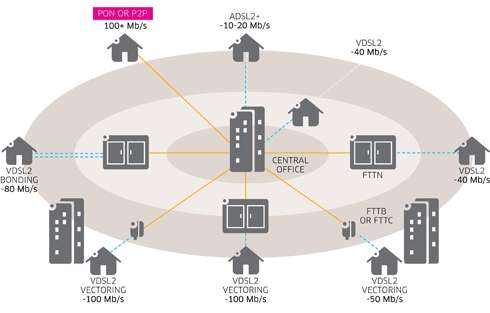October 17, 2011 weblog
Alcatel-Lucent: We've seen the future and it's (still) copper

(PhysOrg.com) -- Alcatel-Lucent is promoting a commercial broadband-over-copper solution. Its new equipment design will deliver better broadband speeds with standard VDSL2 (stands for Very-high-speed Digital Subscriber Line 2) plus vectoring. Alcatel-Lucent says its vectoring approach helps to boost speeds significantly. The telecom giant is letting communications service providers know that the future is copper, still. Now, though, it’s a future with better data speeds and capacity, capable of broadband speeds of 100 Mbps and beyond.
The announcement that the company is taking copper out of the slow lane with VDSL2 vectoring equipment appeared in an article published in Alcatel-Lucent's TechZine, its online magazine. "Boosting VDSL2 Bit Rates with Vectoring" by Paul Spruyt and Dr.Stefaan Vanhastel, said that although fiber deployment is under way, it will require years to complete, in contrast to a copper infrastructure that is widely available.
"These existing resources can be leveraged to help many countries meet their timelines for universal broadband, and service providers can use the copper infrastructure to deliver higher speeds, in less time, with faster return on investment."
The company rests its case on the technology of vectoring, which is “noise-cancellation technology” Vectoring reduces interference between copper lines. With the help of vectoring, VDSL2 lines can approximate their theoretical maximum speed in real-world conditions. Telephone lines that carry VDSL2 signals are part of cables that have ten to a few hundred lines positioned closely together. This close position results in crosstalk.
Vectoring enables each line to perform as if it is alone, without crosstalk. Stanford researchers led by IEEE Fellow John Cioffi, began developing vectoring methods in 2001 for eliminating cross talk for many sets of wires at once.
The TechZine article highlights the following advantages: Vectoring enables 100 Mb/s and beyond over copper lines and allows a very short time to market. It offers a cost-effective way to deliver high bandwidth using existing copper infrastructure.
Alcatel-Lucent has started testing its vectoring technology with carriers already using VDSL2. In 2010, the company started its field trials with service providers including Belgacom, A1 Telekom Austria, Swisscom, Orange, P&T Luxemburg and Türk Telekom. Vectoring improved previous downstream bit rates by 90% to 150%, according to the TechZine article. Alcatel-Lucent will apply its vectoring technology to Belgacom’s triple-play network to enable it to reach speeds of 50 Mbps and beyond. Alcatel-Lucent claims the project will be the world's first commercial introduction of VDSL2 vectoring.
Technology options to fiber for delivering high bandwidth over the next five to ten years is a topic of great interest in communications technology. In most of the developed world, fiber lines all the way to the home still represent only around 5 percent of broadband subscribers. The price tag is a big reason for the small number, according to IEEE Spectrum.
Michael Peeters, chief technology officer of Alcatel-Lucent’s wire-line division, notes that computation for VDSL2 vectoring can be demanding, because of a large matrix of cross talk measurements that need to be considered. ”For 48 lines, it requires as much processing power as a PlayStation 3.” Nonetheless, he estimates, in figuring the decreasing cost of silicon versus the cost of digging for fiber, that the cost of installing VDSL2 with vectoring is still no more than one-third the cost of running fiber all the way to the home.
© 2011 PhysOrg.com
















